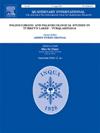Climate and land-cover controls of aquatic carbon dynamics since the last glacial maximum: Evidence from stable carbon isotopes of subfossil Cladocera
IF 1.9
3区 地球科学
Q3 GEOGRAPHY, PHYSICAL
引用次数: 0
Abstract
Lake metabolism and associated emissions of CO2 in lakes are heavily subsidized by terrestrial carbon. However, how land-cover change and long-term climate interact to influence landscape biogeochemistry remains unclear. A ∼26,000-year sediment record from a lake in Southwest China shows how terrestrial-aquatic carbon dynamics responded to climate changes, atmospheric CO2 levels, and changing land-cover (vegetation composition) prior to cultural disturbances. Decoupled and coupled variations in the δ13C of Zooplankton (Bosmina) and sedimentary organic carbon from the Last Glacial Maximum tracked changes in atmospheric CO2 and the δ18O records of monsoonal intensity (Dykoski et al., 2005; Wang et al., 2005), highlighting a primary climatic control on coupled terrestrial-aquatic carbon dynamics. Zooplankton and algal production, alongside Bosmina δ13C-inferred lake CO2 concentrations, exhibited synchronous variations with the intensification of the southwest monsoon from ∼10 cal kyr BP, reflecting both increased aquatic production and enhanced terrestrial carbon export driven by forest expansion. These results highlight the critical role of monsoon-driven hydrological changes in regulating terrestrial organic matter inputs to lakes and shaping aquatic carbon dynamics at timescales of 102–103 year.
求助全文
约1分钟内获得全文
求助全文
来源期刊

Quaternary International
地学-地球科学综合
CiteScore
5.60
自引率
4.50%
发文量
336
审稿时长
3 months
期刊介绍:
Quaternary International is the official journal of the International Union for Quaternary Research. The objectives are to publish a high quality scientific journal under the auspices of the premier Quaternary association that reflects the interdisciplinary nature of INQUA and records recent advances in Quaternary science that appeal to a wide audience.
This series will encompass all the full spectrum of the physical and natural sciences that are commonly employed in solving Quaternary problems. The policy is to publish peer refereed collected research papers from symposia, workshops and meetings sponsored by INQUA. In addition, other organizations may request publication of their collected works pertaining to the Quaternary.
 求助内容:
求助内容: 应助结果提醒方式:
应助结果提醒方式:


